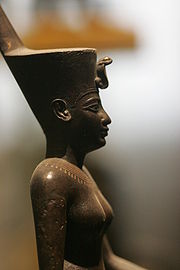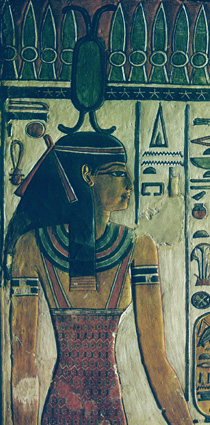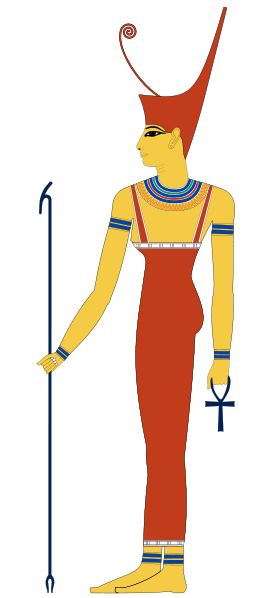
Neith
Neith (Nit, Net, Neit) was an ancient goddess of war and weaving. She was the patron goddess of the Red Crown of Lower Egypt and the city of Zau (Sais, in the 5th Nome of Lower Egtpt) in the Delta. According to the Iunyt (Esna) cosmology, Neith was the creator of the world and the mother of the sun, Ra. This made her the mother of all of the gods and connected her with Nun (a member of the Ogdoad of Hermopolis who was the personification of the primeaval waters of chaos from which Ra emerged at the beginning of time). However, she was also credited with creating Apep, the great serpent and the sworn enemy of Ra, by spitting into the waters of Nun.
She was associated with two different emblems; a shield crossed with two arrows, or a weaving shuttle. It seems that the crossed arrows was her symbol during the predynastic period when she was considered to be a goddess of hunting and war known by the epithet, "Mistress of the Bow, Ruler of Arrows". The crossed arrows also formed the emblem of the town of Zau (Sais) and the name of the nome of which her city was the capital.
The earliest recorded example of Neith being written using the crossed arrows is in the name of Queen Nihotep (thought to be the wife of Hor Aha, Early Dynastic period). It is not clear when the arrows were replaced by the weaving shuttle, or whether this was the result of confusion or an attempt to re-align Neith as a goddess of weaving. One creation myth suggested that she created the world by weaving, and it was sometimes suggested that she was connected to funerary rites because she was responsible for weaving the mummy wrappings (linking her to Nephthys).
Neith is generally regarded as the quintessential war-goddess and huntress deity of the Egyptians since the ancient predynastic period. However, she is a far more complex goddess than is generally known, and of whom ancient texts only hint of her true nature. In her usual representations, she is portrayed as a fierce deity, a human female wearing the Red Crown, occasionally holding or using the bow and arrow, in others a harpoon. In fact, the hieroglyphs of her name are usually followed by a determinative containing the archery elements, with the "shield" symbol of the name being explained as either double bows (facing one another), intersected by two arrows (usually lashed to the bows), or by other imagery associated with her worship.

Neith was a powerful and popular deity who the other gods apparently consulted when they could not settle a dispute. For example, according to myth is was Neith who eventually ruled that Horus would be king of Upper and Lower Egypt instead of Set. In compensation she gave Set land and blessed his wedding to two foreign goddeses (Anat and Astarte).
Her family relationships were typically confusing. During the Old Kingdom, she was regarded as the wife of Set (making it unlikely she would be called to rule against him and grant him extra wives!). However, her association with Set was dropped as he was re-interpreted as a force of evil. She was often considered to be the mother of Sobek, the crocodile god. In the Pyramid texts in Unas' tomb she is given the epithet "Nurse of Crocodiles". Yet, in later times she was considered to be the wife of Sobek rather than his mother. In addition, she was sometimes described as the wife of Khnum in Upper Egypt.
In the form of a cow, she was linked to both Nut and Hathor and in late dynastic times she was regarded as a form of Hathor. She was also linked to Tatet (the goddess who dressed the dead). Herodotus described the annual festival in honour of Isis-Neith. Lamps and torches were kept burning until the morning, while everyone enjoyed a feast.
Neith was associated with Anubis and Wepwawet (Upuaut), because of her epithet "Opener of the Ways". She was also one of the four goddesses (along with Isis, Nephthys and Serqet/Selket) who protected the deceased and the canopic jars (which were topped by the four sons of Horus ). Neith guarded the east side of the sarcophagus and protected Duamutef (the the jackal-headed god) as he watched over the stomach.

Neith was usually depicted as a woman wearing the Red Crown of Lower Egypt, but was occasionally depicted as a cow in connection with her role as the mother of Ra (linking her with Hathor, Hesat and Bat). Her name links her with the crown of Lower Egypt which was known as "nt" . However, her name is also linked to the word for weaving ('ntt') and to one of the words used for water ("nt"). When she is referred to as the creator of the world her name is written using the hieroglyph of an ejaculating phallus, indicating that she was considered as an androgynous creator.
As a deity, Neith is normally shown carrying the wAs (was) scepter (symbol of rule and power) and the anH (ankh) (symbol of life). She is also called such cosmic epithets as the "Cow of Heaven," a sky-goddess similar to Nut and as the Great Flood, Mehetweret (MHt wr.t), who gives birth to the sun daily. In these forms, she is associated with creation of both the primeval time and daily "re-creation." As protectress of the Royal House, she is represented as a uraeus, and functions with the fiery fury of the sun, not unlike the Eye facets of Hathor.